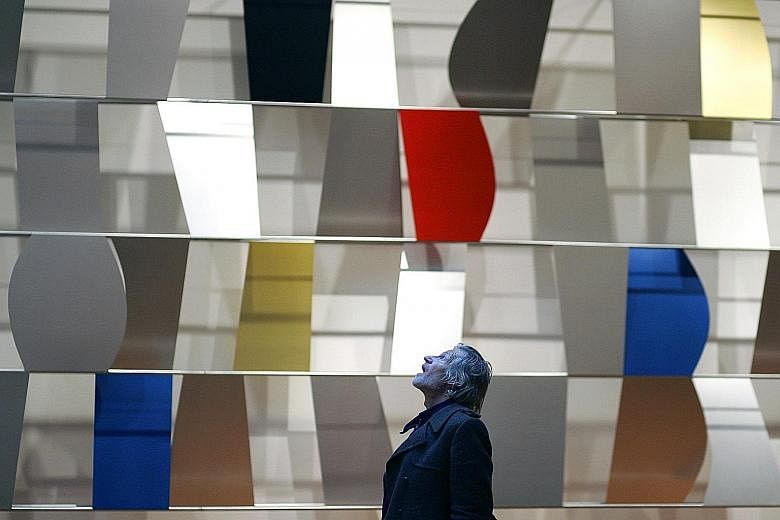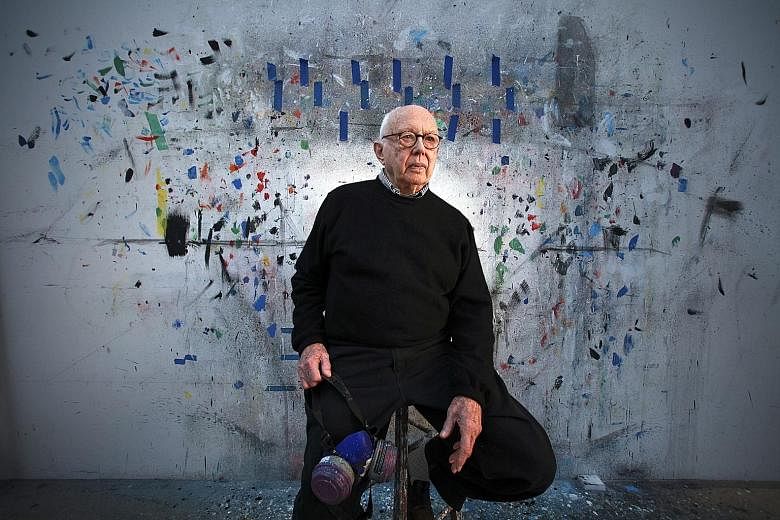NEW YORK • Ellsworth Kelly, one of America's great 20th-century abstract artists, who in the years after World War II shaped a dis- tinctive style of American painting by combining the solid shapes and brilliant colours of European abstraction with forms drawn from everyday life, died on Sunday at his home in Spencertown, New York. He was 92.
His death was announced by Mr Matthew Marks of the Matthew Marks Gallery in Manhattan.
Born in Newburgh, New York, on May 31, 1923, Kelly studied painting at the School of the Museum of Fine Arts in Boston after his discharge from the Army in 1945.
But his formative years as an artist were in Paris, which he had visited briefly during World War II and where he returned to live in 1948 with support from the GI Bill.
When he arrived, he was painting figures influenced by Picasso and Byzantine mosaics. But he quickly immersed himself in museums, adding both Asian art and Matisse to his eclectic store of influences.
He also spent time outside Paris visiting Romanesque churches and the relationship between art and architecture remained important to him, evident in the many public commissions he completed late in his career.
Within a year of his arrival, he was painting his first abstract pictures using a mix of chance elements and references to nature, which he defined as everything seen in the real world.
"I started to look at the city around me and that became my source," he said.
The early paintings and drawings were derived from patterns found in sidewalk grates or configurations of pipes on the side of a building. A painted wood cutout, Window, Museum Of Modern Art, Paris (1949), corresponded in dimensions and form to the title object.
Kelly's use of found elements led him to create purely abstract paintings composed of randomly arranged and joined coloured panels, a radical move even for him.
"I wondered, 'Can I make a painting with just five panels of colour in a row?' I loved it, but I didn't think the world would. They'd think, 'It's not enough.'"
It did take time for the art world to catch up with him. Although he had a one-person show in Paris in 1951, there was scant response and he was turned down for several group exhibitions.
Meanwhile, his GI Bill support was coming to an end, forcing him to seek jobs as an art teacher, a textile designer and a custodian.
In 1954, after reading a favourable review in ARTnews of an Ad Reinhardt show in New York City, he began to think that his own fairly spare abstract work might find favour there and he returned to the US.
Short on cash when he arrived, he ended up living in a half-deserted section of Lower Manhattan near South Street Seaport, in a 19th- century sailmaker's loft on Coenties Slip.
Despite his remote location, the art world found him. Dealer Betty Parsons, who also represented Reinhardt, visited Kelly's studio and offered him a solo exhibition in 1956.
In 1957, the Whitney Museum of American Art bought a painting, Atlantic, which depicted two white wave-like arcs against solid black. It was Kelly's first museum purchase.
In 1959, Dorothy C. Miller, the influential Museum of Modern Art curator, included Kelly's work in Sixteen Americans, an important survey of emerging artists that included Jasper Johns, Robert Rauschenberg and Youngerman.
In 1973, he had his first American retrospective at the Museum of Modern Art in New York. His first major European retrospective was at the Stedelijk Museum in Amsterdam in 1979.
One of his most moving installations was one of his quietest. Made for the United States Holocaust Memorial Museum in Washington, it consisted of a plain white fan-shaped form floating opposite a triptych of three rectangular white panels. Suggesting the image of a great bird lifting upward over closed windows, the piece distilled the rigorously refined visual vocabulary Kelly had developed over a long career.
In 2013, he received the National Medal of Arts, considered the nation's highest honour for artistic excellence, from US President Barack Obama.
He is survived by his husband and a brother.
Although he was interested in history and concerned about his place in it, he spoke of his own work as existing "forever in the present".
"I think what we all want from art is a sense of fixity, a sense of opposing the chaos of daily living," he said. "This is an illusion, of course. What I've tried to capture is the reality of flux, to keep art an open, incomplete situation, to get at the rapture of seeing."
NEW YORK TIMES


